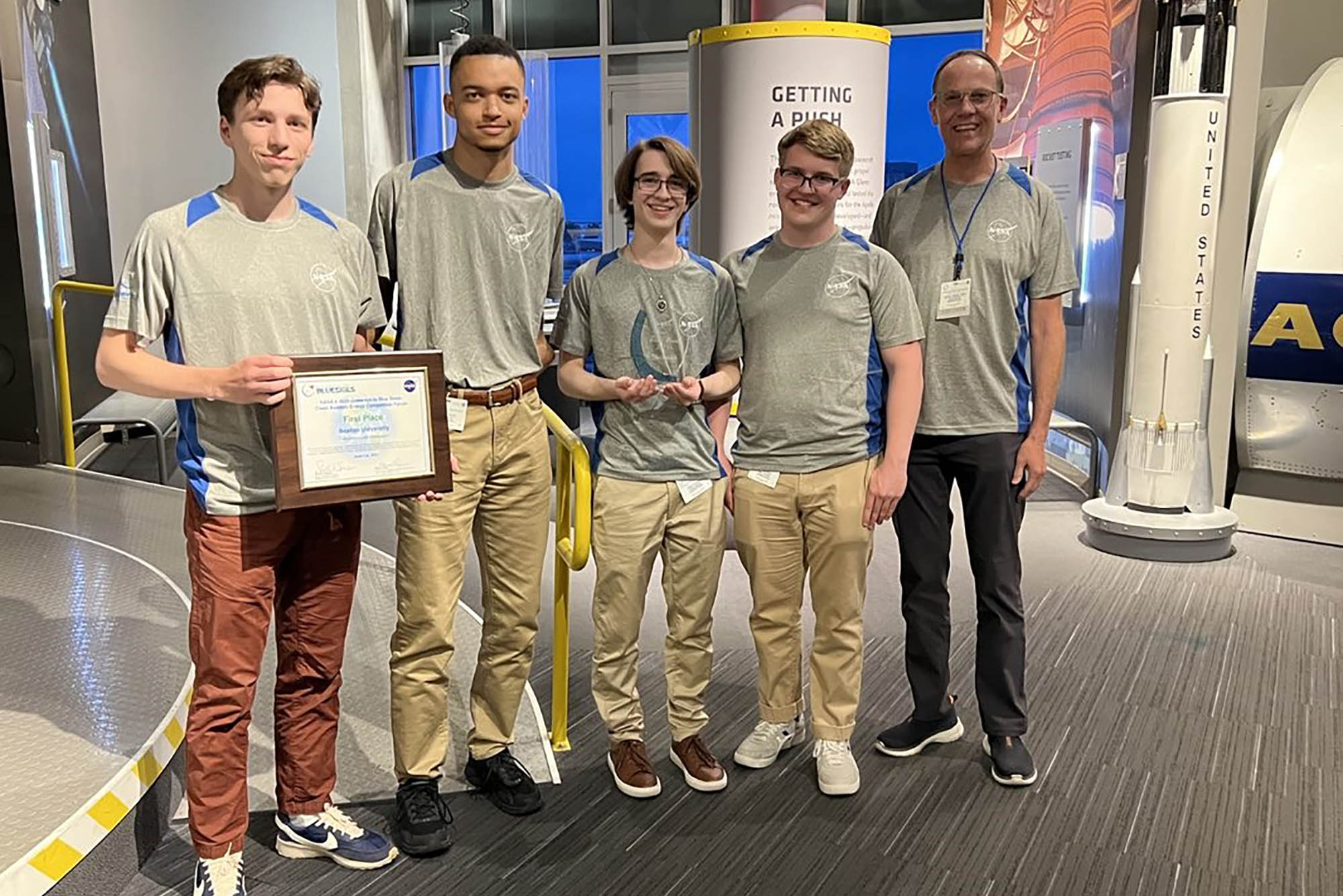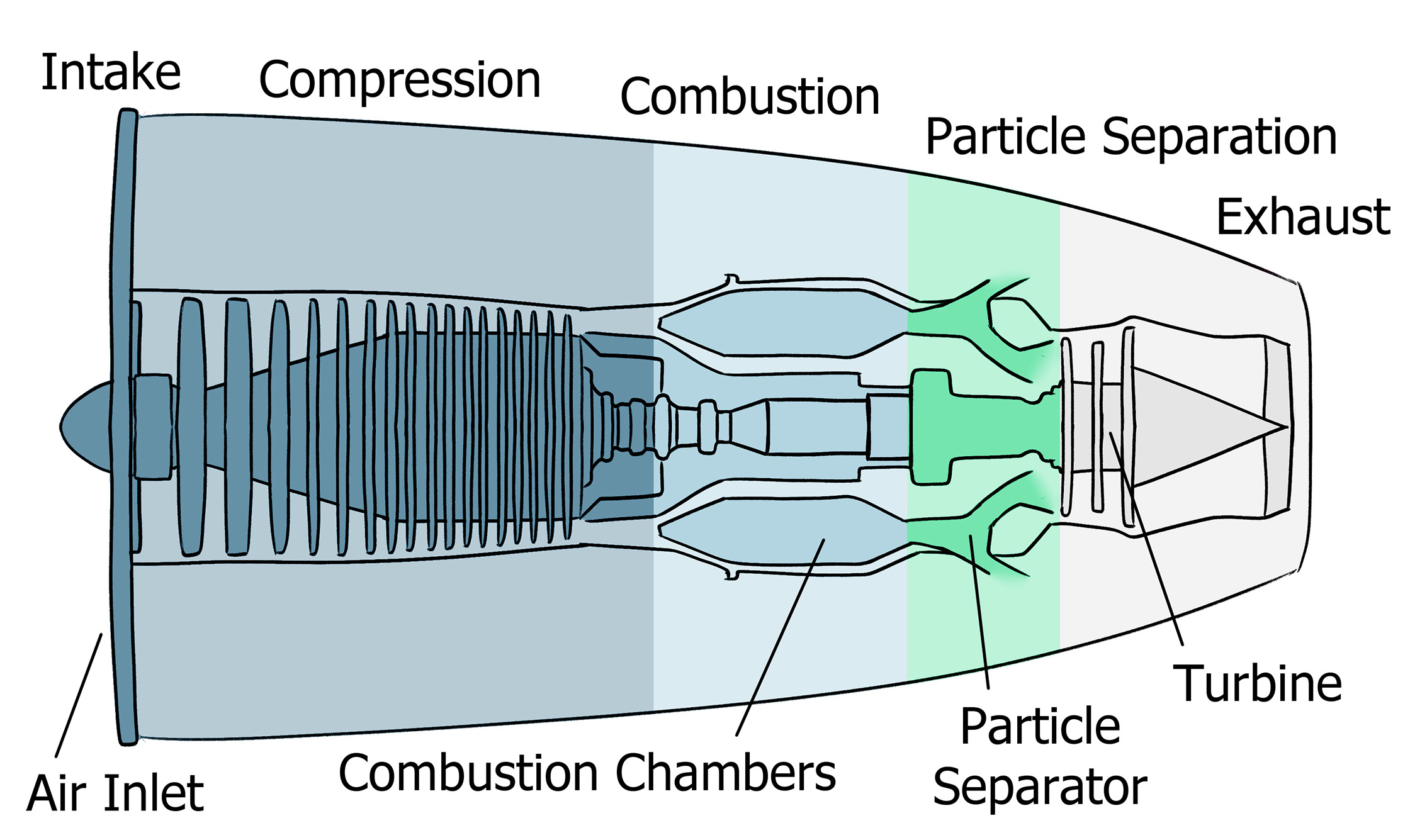Sky High—ENG Terriers Win NASA Student Competition on Clean Aviation Energy

Max Pounanov (ENG’23) (from left), Michael Osuji (ENG’23), Odin Francis (ENG’23), and Patrick Olah (ENG’23) with their faculty advisor, Jim Geiger (ENG’93), shortly after winning NASA’s Gateways to Blue Skies: Clean Aviation Energy student competition in Cleveland June 2. Photo courtesy of the National Institute of Aerospace
Sky High—ENG Terriers Win NASA Student Competition on Clean Aviation Energy
Team of young alums is working to create a future flying free of fossil fuels
Days after graduating from Boston University, a team of newly minted engineers won a NASA competition with a proposal to make tomorrow’s aviation industry cleaner by running on aluminum powder instead of jet fuel. As part of their project, the team designed a jet engine that, if built, would look similar to today’s gas turbine engines but with the addition of a segment called a particle separator, which would allow aluminum powder to mix efficiently with air and generate the thrust needed for flight.
Odin Francis (ENG’23), Patrick Olah (ENG’23), Michael Osuji (ENG’23), and Max Pounanov (ENG’23) labored over their innovative design throughout their senior year, and in early June they took first place in the second annual Gateways to Blue Skies: Clean Aviation Energy student competition, held at NASA’s Glenn Research Center in Cleveland.
“It’s overwhelming,” says Olah. “Eight months ago I had no idea how aluminum powder might be used to power an airplane, but I’m so glad we picked this topic for our senior design project and just dived in. It’s like the butterfly effect [the idea that small things can have nonlinear impacts on a complex system].” The four young alums have been offered internships in NASA aeronautics centers as a result of their victory.
Today’s aircraft have an outsized impact on the environment because they emit carbon dioxide high up in the atmosphere, where it causes more significant planet-warming reactions than emissions down lower. To help find a solution, NASA invited university students to suggest bold alternatives to fossil fuels. Sponsored by the agency’s Aeronautics Research Mission Directorate, the Blue Skies competition asked students to choose and investigate the viability of an under-studied energy source with the potential to bring airplane emissions down toward zero. The scholars needed to analyze the life cycle of their proposed energy source, from extraction and refinement to flight.
Advised by Jim Geiger (ENG’93), a College of Engineering lecturer in mechanical engineering, the team began scouring existing studies of combustion last fall as part of a project for credit. All were seniors in mechanical engineering (Francis double-majored in physics), with concentrations in aerospace.
They became intrigued by one research paper describing aluminum powder powering a simple four-cylinder engine, and they extrapolated this process to future use in commercial flight. They submitted a preliminary proposal to the NASA competition, earned a spot in the finals, then kicked their research into high gear, preparing to make their case to agency officials and industry experts in Cleveland.
“The way it works is that in an engine, you want to heat up the air and move it fast out the back, essentially,” Olah says. “Today that’s done with jet fuel. We wanted to mimic this using aluminum powder, which reacts with oxygen to create the same combustion, but without releasing harmful carbon dioxide emissions.”

Moreover, the team made an exhaustive study of the aluminum mining and refining infrastructure. The smelting process that turns bauxite rock into aluminum powder comes with its own environmental challenges. In the new system the team devised, the first step would be to modify the smelting process to cut emissions. And fortunately, a further solution is contained within the team’s jet engine design: a byproduct of the aluminum powder combustion is aluminum oxide—an essential ingredient in aluminum powder. The process would become cyclical, and mining would be phased out after 2050.
At the two-day event in Cleveland, each team had 25 minutes to present their research, followed by 20 minutes of questioning from the NASA judges.
“They paid attention to the details and took the time to answer every single question,” says Geiger. “The cost question was a tough one, because their process would actually cost twice as much as today’s. That’s not an attractive answer, ‘2x,’ but they went over and over and over it and couldn’t find any way to get the cost down.” Rather than an evasion, the team offered an informed response, Geiger says—“If you want to fix this problem, this is what it’s going to cost.”
In the end, the judges were more interested in a different figure: the drop in carbon dioxide emissions. The team calculated that their process, soup to nuts, would cut down on the aviation industry’s emissions of the harmful greenhouse gas by 96 percent.
“The judges were super nice,” says Olah. “It didn’t feel like a high-pressure setting. It felt like a collaborative environment. One of the coolest aspects was meeting all the other kids,” who ranged from freshmen to PhD students, “and hearing all their innovative ideas and ways of thinking about this problem.” Other proposed alternatives included hydrogen, solar, and energy beam bursts.
Remarkably, there was another team from BU in the finals—and they, too, focused on metal powder as a potential fuel source. “It was just a big coincidence,” marvels Olah. “But we were rooting for them, 100 percent.”
Tony Linn, an ENG professor of the practice, advised the second group—Hadassah Flagg (ENG’23), Kaylea Gaughan (ENG’23), Emily Osurman (ENG’23), and Michelle Ramoska (ENG’23). In their scenario, iron powder would be fluidized with air to generate the energy needed for flight. Rather than emitting carbon, the process would produce iron oxide as a byproduct, and—just as with aluminum—this could be recycled back into producing more iron powder. Linn’s students, too, were all mechanical engineering seniors. Flagg, Gaughan, and Osurman also concentrated in energy technology and sustainability.
The other six teams in the finals were from Carnegie Mellon, Texas A&M, Manhattan College, University of California San Diego, and the University of Texas at Austin.
“All the teams were very professional and polished,” says Geiger, who has advised BU teams in NASA student competitions for a decade. But Francis, Olah, Osuji, and Pounanov “are a very special group,” he says. “The sky’s the limit with these guys.”
Patrick L. Kennedy is writer-editor in BU’s College of Engineering and can be reached at plk@bu.edu.
Comments & Discussion
Boston University moderates comments to facilitate an informed, substantive, civil conversation. Abusive, profane, self-promotional, misleading, incoherent or off-topic comments will be rejected. Moderators are staffed during regular business hours (EST) and can only accept comments written in English. Statistics or facts must include a citation or a link to the citation.